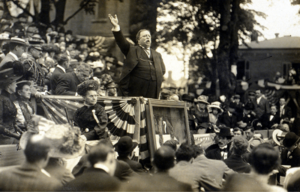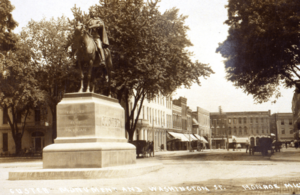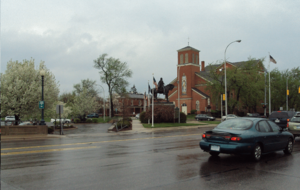George Armstrong Custer Equestrian Monument facts for kids
|
George Armstrong Custer
Equestrian Monument |
|
 |
|
| Location | Junction of Elm Avenue and North Monroe Street Monroe, Michigan |
|---|---|
| Built | 1910 |
| Architect | Hunt & Hunt |
| Sculptor | Edward Clark Potter |
| NRHP reference No. | 94001430 |
Quick facts for kids Significant dates |
|
| Added to NRHP | December 9, 1994 |
The George Armstrong Custer Equestrian Monument is a special statue of General George Armstrong Custer riding a horse. You can find it in Monroe, Michigan. This statue is also known as Sighting the Enemy.
The famous sculptor Edward Clark Potter created the statue. It was officially named a Michigan Historic Site on June 15, 1992. Later, on December 9, 1994, it was added to the National Register of Historic Places. This means it's recognized as an important historic place for the whole country.
Who Was General Custer?
Even though George Custer wasn't born in Monroe, he spent a lot of his childhood there. He lived with relatives and went to school in the city. While growing up, he met Elizabeth Bacon, who would later become his wife in 1864.
Custer left Monroe to attend the United States Military Academy, a famous military school. He then fought in the Civil War. He worked very hard and was successful during the war. Because of this, and because the Union army needed more leaders, he became a major general. This made him a very well-known military person.
After the Civil War, Custer fought in the Indian Wars in the western parts of the country. However, his earlier successes were later overshadowed. He faced a major defeat and died at the Battle of the Little Bighorn on June 25, 1876.
To honor his achievements, a large bronze statue was created. It cost $24,000 and stands 14 feet (4.27 meters) tall. The statue was officially revealed in Monroe in June 1910. President William Howard Taft and Custer's wife, Elizabeth Bacon Custer, were there for the event. The statue celebrates Custer's brave actions during the Civil War, not his later defeat.
Where the Statue Has Been
Over the years, the Custer statue has been moved three times. When it was first put up, it stood in the middle of the brick-paved intersection of First and Washington streets. This area is now part of the Old Village Historic District.
Custer's wife, Elizabeth, felt the statue deserved a better spot. She spent much of her later life trying to improve Custer's public image. Some people in Monroe also complained that the statue was a traffic problem. When it was first built, there weren't many cars, but traffic was quickly growing.
So, on June 20, 1923, the statue was moved. Its new home was in Soldiers and Sailors Park, next to the River Raisin. But in this spot, the statue was quite lonely. It eventually became hidden by overgrown bushes and trees.
Because people protested, the city decided to move the statue again in August 1955. When the movers arrived, they actually had trouble finding the statue because it was so hidden by plants!
The statue was moved to its current location. It now stands on the southwest corner of Elm Avenue and North Monroe Street, still along the River Raisin. This is one of the busiest intersections in Monroe. The statue is also well-lit at night, making it easy to see. Today, it's one of the most famous landmarks in Monroe. The Custer statue is across Elm Street from the St. Mary's Church Complex Historic District. It is also next to the East Elm-North Macomb Street Historic District.
About the Monument
People who support the statue say it honors Custer's great service to the Union during the Civil War. It does not focus on his defeat at the Battle of the Little Bighorn. The statue shows Custer wearing his Civil War uniform.
In statues of people on horseback, if the horse has all four feet on the ground, it means the person did not die in battle during that time. Since Custer did not die during the Civil War, his horse in the statue has all four feet on the ground.
A special historical marker near the statue tells its story: George A. Custer was born in New Rumley, Ohio. He grew up in Monroe at the home of his half-sister, Mrs. David Reed. On February 9, 1864, he married Libbie Bacon in the Presbyterian Church here. She was the only daughter of Judge and Mrs. Daniel S. Bacon.
During the Civil War, Custer served with great skill. He fought in important battles like the Battle of Gettysburg. He received many honors and became a brigadier-general before he was 26 years old. This was a very rare achievement.
From 1866 until his death, Custer led the famous Seventh Cavalry Regiment. They were involved in scouting and fighting Native American tribes across Kansas and the Dakota Territory. When he died at the Battle of the Little Bighorn, his rank was lieutenant colonel. He had returned to this rank after the Civil War ended.
The State of Michigan built this statue of General Custer. Edward C. Potter created it. Mrs. Elizabeth B. Custer unveiled it, and President William Howard Taft dedicated it on June 4, 1910. The statue was rededicated on September 3, 1955. This was done by members of the First Cavalry Division, which included Custer's Seventh Cavalry Regiment.






